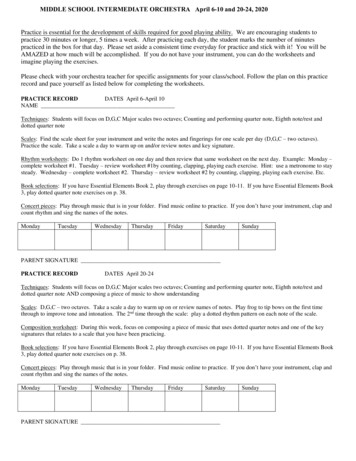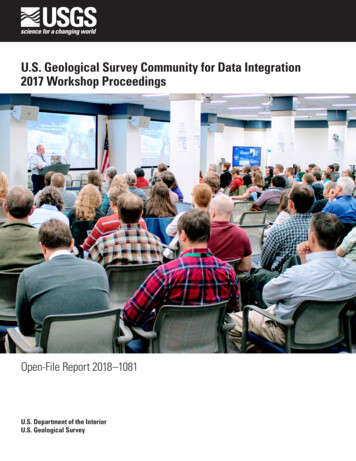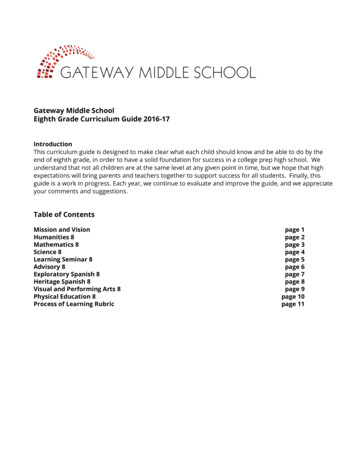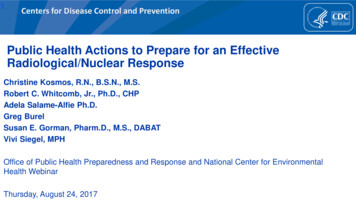
Transcription
EPTCS 111Proceedings of theEighth Workshop onModel-Based TestingRome, Italy, 17th March 2013Edited by: Alexander K. Petrenko and Holger Schlingloff
Published: 2nd March 2013DOI: 10.4204/EPTCS.111ISSN: 2075-2180Open Publishing Association
Table of ContentsPreface . . . . . . . . . . . . . . . . . . . . . . . . . . . . . . . . . . . . . . . . . . . . . . . . . . . . . . . . . . . . . . . . . . . . . . . . . . . . . . . . . . . .Alexander K. Petrenko and Holger Schlingloff1Invited Talk: Industrial-Strength Model-Based Testing - State of the Art and Current Challenges . .Jan Peleska3Industrial Presentation: Model-Based testing for LTE Radio Base Station . . . . . . . . . . . . . . . . . . . . . . 29Olga GrinchteinIndustrial Presentation: Towards the Usage of MBT at ETSI . . . . . . . . . . . . . . . . . . . . . . . . . . . . . . . . . . 30Jens Grabowski, Victor Kuliamin, Alain-Georges Vouffo Feudjio, Antal Wu-Hen-Chang andMilan ZoricTesting Java implementations of algebraic specifications . . . . . . . . . . . . . . . . . . . . . . . . . . . . . . . . . . . . . . . 35Isabel Nunes and Filipe LuísDecomposability in Input Output Conformance Testing . . . . . . . . . . . . . . . . . . . . . . . . . . . . . . . . . . . . . . . . 51Neda Noroozi, Mohammad Reza Mousavi and Tim A.C. WillemseRuntime Verification Based on Executable Models: On-the-Fly Matching of Timed Traces . . . . . . . . 67Mikhail Chupilko and Alexander KamkinTop-Down and Bottom-Up Approach for Model-Based Testing of Product Lines . . . . . . . . . . . . . . . . . 82Stephan Weißleder and Hartmut Lackner
1PrefaceThis volume contains the proceedings of the Eighth Workshop on Model-Based Testing (MBT 2013),which was held in Rome on March 17, 2013 as a satellite workshop of the European Joint Conferenceson Theory and Practice of Software (ETAPS 2013).The first workshop on Model-Based Testing (MBT) in this series took place in 2004, in Barcelona. Atthat time model-based testing already had become a hot topic, but MBT 2004 was the first event devotedexclusively to this domain. Since that time the area has generated enormous scientific and industrialinterest, and today there are several other workshops and conferences on software and hardware designand quality assurance covering also model based testing. For example, this year ETSI organizes theUCAAT (User Conference on Advanced Automated Testing) with a focus on ”model-based testing inthe testing ecosystem”. Still, the MBT series of workshops offers a unique opportunity to share newtechnological and foundational ideas particular in this area, and to bring together researchers and usersof model-based testing to discuss the state of the theory, applications, tools, and industrialization.Model-based testing has become one of the most powerful system analysis methods, where the rangeof possible applications is still growing. Currently, we see the following main directions of MBT development. Integration of model-based testing techniques with various other analysis techniques; in particular,integration with formal development methods and verification tools; Application of the technology in the certification of safety-critical systems (this includes establishing acknowledged coverage criteria and specification-based test oracles); Use of new notations and new kinds of modeling formalisms along with the elaboration of approaches based on usual programming languages and specialized libraries; Integration of model-based testing into continuous development processes and environments (e.g.,for software product lines).The invited talk and paper of Jan Peleska in this volume gives a nice survey of current challenges.Furthermore, the submitted contributions, selected by the program committee, reflect the above researchtrends. Isabel Nunes and Filipe Luı́s consider the integration of model-based testing with algebraic specifications for the testing of Java programs. Neda Noroozi, Mohammad Reza Mousavi and Tim A.C.Willemse analyze criteria for the decomposability of models in the theory of input-output conformance(ioco) testing. Mikhail Chupilko and Alexander Kamkin extend model-based testing to runtime verification: they develop an online algorithm for conformance of timed execution traces with respect to timedautomata. Stephan Weissleder and Hartmut Lackner compare different approaches for test generationfrom variant models and feature models in product line testing.In 2012 the ”industrial paper” category was added to the program. This year we have two acceptedindustrial presentations, both from the telecommunications domain: Jens Grabowski, Victor Kuliamin,Alain-Georges Vouffo Feudjio, Antal Wu-Hen-Chang and Milan Zoric report on the evaluation of fourdifferent model-based testing tools for standardization at ETSI, the European Telecommunications Standards Institute. Olga Grinchtein gave a talk on the experiences gained by the application of model-basedtesting for base stations of LTE, the European 4G mobile phone network.We would like to thank the program committee members and all reviewers for their work in evaluating the submissions. We also thank the ETAPS 2013 organizers for their assistance in the preparation ofthe workshop and the EPTCS editors for help in publishing these proceedings.Alexander K. Petrenko and Holger Schlingloff, February 2013.
2Program committee Bernhard Aichernig (Graz University of Technology, Austria) Jonathan Bowen (University of Westminster, UK) Mirko Conrad (The MathWorks GmbH, Germany) John Derrick (University of Sheffield, UK) Bernd Finkbeiner (Universitat des Saarlandes, Germany) Lars Frantzen (Radboud University Nijmegen , Netherlands) Patrice Godefroid (Microsoft Research, USA) Wolfgang Grieskamp (Google, USA) Ziyad Hanna (Jasper Design Automation, USA) Philipp Helle (EADS, Germany) Antti Huima (Conformiq Software Ltd., Finland) Mika Katara (Tampere University of Technology, Finland) Alexander S. Kossatchev (ISP RAS, Russia) Andres Kull (Elvior, Estonia) Bruno Legeard (Smartesting, France) Bruno Marre (CEA LIST, France) Laurent Mounier (VERIMAG, France) Alexander K. Petrenko (ISP RAS, Russia) Alexandre Petrenko (Computer Research Institute of Montreal, Canada) Fabien Peureux (University of Franche-Comte, France) Holger Schlingloff (Fraungofer FIRST, Germany) Julien Schmaltz (Open University of The Netherlands, Netherlands) Nikolai Tillmann (Microsoft Research, USA) Stephan Weissleder (Fraunhofer FOKUS, Germany ) Nina Yevtushenko (Tomsk State University, Russia)Additional reviewers Igor Burdonov (ISP RAS, Russia) Maxim Gromov (Tomsk State University, Russia)
Industrial-Strength Model-Based Testing - State ofthe Art and Current Challenges Jan PeleskaUniversity of Bremen, Department of Mathematics and Computer Science, Bremen, GermanyVerified Systems International GmbH, Bremen, Germanyjp@informatik.uni-bremen.deAs of today, model-based testing (MBT) is considered as leading-edge technology in industry.We sketch the different MBT variants that – according to our experience – are currentlyapplied in practice, with special emphasis on the avionic, railway and automotive domains.The key factors for successful industrial-scale application of MBT are described, both froma scientific and a managerial point of view. With respect to the former view, we describe thetechniques for automated test case, test data and test procedure generation for concurrentreactive real-time systems which are considered as the most important enablers for MBT inpractice. With respect to the latter view, our experience with introducing MBT approachesin testing teams are sketched. Finally, the most challenging open scientific problems whosesolutions are bound to improve the acceptance and effectiveness of MBT in industry arediscussed.1Introduction1.1Model-Based TestingFollowing the definition currently given in Wikipedia1“Model-based testing is application of Model based design for designing and optionallyalso executing artifacts to perform software testing. Models can be used to representthe desired behavior of an System Under Test (SUT), or to represent testing strategiesand a test environment.”In this definition only software testing is referenced, but it applies to hardware/softwareintegration and system testing just as well. Observe that this definition does not require thatcertain aspects of testing – such as test case identification or test procedure creation – should beperformed in an automated way: the MBT approach can also be applied manually, just as designsupport for testing environments, test cases and so on. This rather unrestricted view on MBT isconsistent with the one expressed in [2], and it is reflected by today’s MBT tools ranging fromgraphical test case description aides to highly automated test case, test data and test proceduregenerators. Our concept of models also comprises computer programs, typically represented byper-function/method control flow graphs annotated by statements and conditional expressions.Automated MBT has received much attention in recent years, both in academia and in industry. This interest has been stimulated by the success of model-driven development in general,by the improved understanding of testing and formal verification as complementary activities, Theauthor’s research is funded by the EU FP7 COMPASS project under grant agreement no.287829(date: 2013-0211).1 http://en.wikipedia.org/wiki/Model-based testing,A. Petrenko, H. Schlingloff (Eds.): Eighth Workshop onModel-Based Testing (MBT 2013)EPTCS 111, 2013, pp. 3–28, doi:10.4204/EPTCS.111.1c Jan PeleskaThis work is licensed under theCreative Commons Attribution License.
4Industrial-Strength Model-Based Testingand by the availability of efficient tool support. Indeed, when compared to conventional testing approaches, MBT has proven to increase both quality and efficiency of test campaigns; wename [21] as one example where quantitative evaluation results have been given.In this paper the term model-based testing is used in the following, most comprehensive,sense: the behaviour of the system under test (SUT) is specified by a model elaborated in thesame style as a model serving for development purposes. Optionally, the SUT model can bepaired with an environment model restricting the possible interactions of the environment withthe SUT. A symbolic test case generator analyses the model and specifies symbolic test cases aslogical formulas identifying model computations suitable for a certain test purpose. Constrainedby the transition relations of SUT and environment model, a solver computes concrete modelcomputations which are witnesses of the symbolic test cases. The inputs to the SUT obtainedfrom these computations are used in the test execution to stimulate the SUT. The SUT behaviourobserved during the test execution is compared against the expected SUT behaviour specified inthe original model. Both stimulation sequences and test oracles, i. e., checkers of SUT behaviour,are automatically transformed into test procedures executing the concrete test cases in a modelin-the-loop, software-in-the-loop, or hardware-in-the-loop configuration.According to the MBT paradigm described here, the focus of test engineers is shifted fromtest data elaboration and test procedure programming to modelling. The effort invested intospecifying the SUT model results in a return of investment, because test procedures are generatedautomatically, and debugging deviations of observed against expected behaviour is considerablyfacilitated because the observed test executions can be “replayed” against the model. Moreover,V&V processes and certification are facilitated because test cases can be automatically tracedagainst the model which in turn reflects the complete set of system requirements.1.2Objectives of this PaperThe objective of this paper is to describe the capabilities of MBT tools which – accordingto our experience – are fit for application in today’s industrial scale projects and which areessential for successful MBT application in practice. The MBT application field considered hereis distributed embedded real-time systems in the avionic, automotive and railway domains. Thedescription refers to our tool RT-Tester2 for illustrating several aspects of MBT in practice,and the underlying methods that helped to meet the test-related requirements from real-worldV&V campaigns. The presentation is structured according to the MBT researchers’ and toolbuilders’ perspective: we describe the ingredients that, according to our experience, should bepresent in industrial-strength test automation tools, in order to cope with test models of the sizestypically encountered when testing embedded real-time systems in the automotive, avionic orrailway domains. We hope that these references to an existing tool may serve as “benchmarkinginformation” which may motivate other researchers to describe alternative methods and theirvirtues with respect to practical testing campaigns.2 Thetool has been developed by Verified Systems International in cooperation with the author’s team at theUniversity of Bremen. It is available free of charge for academic research, but commercial licenses have to beobtained for industrial application. Some components (e.g., the SMT solver) will also become available as opensource.
Jan Peleska1.35OutlineIn Section 2 a tool introduction is given. In Section 3, MBT methods and challenges relatedto modelling are discussed. Section 4 introduces a formal view on requirements, test cases andtheir traceability in relation to the test model. It also discusses various test strategies and theirjustification. A case study illustrating various points of our discussion of MBT is described inAppendix A. Section 5 presents the conclusion. We give references to alternative or competingmethods and tools along the way, as suitable for the presentation.2A Reference MBT ToolRT-Tester supports all test levels from unit testing to system integration testing and providesdifferent functions for manual test procedure development, automated test case, test data andtest procedure generation, as well as management functions for large test campaigns. The typical application scope covers (potentially safety-critical) embedded real-time systems involvingconcurrency, time constraints, discrete control decisions as well as integer and floating pointdata and calculations. While the tool has been used in industry for about 15 years and hasbeen qualified for avionic, automotive and railway control systems under test according to thestandards [33, 20, 38], the results presented here refer to more recent functionality that has beenvalidated during the last years in various projects from the transportation domains and are nowmade available to the public.The starting point for MBT is a concrete test model describing the expected behaviour ofthe system under test (SUT) and, optionally, the behaviour of the operational environment to besimulated in test executions by the testing environment (TE) (see Fig. 1). Models developed in aspecific formalism are transformed into some textual representation supported by the modellingtool (usually XMI format). A model parser front-end reads the model text and creates aninternal model representation (IMR) of the abstract syntax.A transition relation generator creates the initial state and the transition relation of the modelas an expression in propositional logic, referring to pre-and post-states. Model transformerscreate additional reduced, abstracted or equivalent model representations which are useful tospeed up the test case and test data generation process.A test case generator creates propositional formulas representing test cases built accordingto a given strategy. A satisfiability modulo theory (SMT) solver calculates solutions of the testcase constraints in compliance with the transition relation. This results in concrete computation fragments yielding the time stamps and input vectors to be used in the test procedureimplementing the test case (and possibly other test cases as well). An interpreter simulating themodel in compliance with the transition relation is used to investigate concrete model executionscontinuing the computation fragments calculated by the SMT solver or, alternatively, creatingnew computations based on environment simulation and random data selection. An abstractinterpreter supports the SMT solver in finding solutions faster by calculating the minimum number of transition steps required to reach the goal, and by restricting the ranges of inputs andother model variables for each state possibly leading to a solution. Finally, the test proceduregenerator creates executable test procedures as required by the test execution environment bymapping the computations derived before into time-controlled commands sending input data tothe SUT and by creating test oracles from the SUT model portion checking SUT reactions onthe fly, in dependency of the stimuli received before from the TE.
6Industrial-Strength Model-Based TestingFigure 1: Components of the RT-Tester test case/test data generator.33.1Modelling AspectsModelling FormalismsIt is our expectation that the ongoing discussions about suitable modelling formalisms for reactive systems – from UML via process algebras and synchronous languages to domain-specificlanguages – will not converge to a single preferred formalism in the near future. As a consequence it is important to separate the test case and test data generation algorithms fromconcrete modelling formalisms.RT-Tester supports subsets of UML [24] and SysML [23] for creating test models: SUT structure is expressed by composite structure or block diagrams, and behaviour is specified by meansof state machines and operations (a small SysML-based case study is presented Appendix A).The parser front end reads model exports from different tools in XMI format. Another parserreads Matlab/Simulink models. For software testing, a further front end parses transition graphsof C functions.
Jan Peleska7The first versions of RT-Tester supported CSP [35] as modelling language, but the processalgebraic presentation style was not accepted well by practitioners. Support for an alternativetextual formalism is currently elaborated by creating a front-end for CML [43], the COMPASSmodelling language specialised on systems of systems (SoS) design, verification and validation.In CML, the problems preventing a wider acceptance of CSP for test modelling have beenremoved.Some formalisms are domain-specific and supported on customers’ request: in [21] automatedMBT against a timed variant of Moore Automata is described, which is used for modelling controllogic of level crossing systems.3.2A Sample ModelIn Appendix A a case study is presented which will be used in this paper to illustrate modellingtechniques, test case generation and requirements tracing. The case study models the turnindication and emergency flashing functions as present in modern vehicles. While this studyis just a small simplified example, a full test model of the turn indication function as realisedin Daimler Mercedes cars has been published in [26] and is available under http://www.mbtbenchmarks.org.3.3Semantic ModelsIn addition to the internal model representation which is capable of representing abstract syntaxtrees for a wide variety of formalisms, a semantic model is needed which is rich enough to encodethe different behaviours of these formalisms. As will be described in Section 4, operationalmodel semantics is the basis for automated test data generation, and it is also needed to specifythe conformance relation between test model and SUT, which is checked by the tests oraclesgenerated from the model (see below).A wide variety of semantic models is available and suitable for test generation. Differentvariants of labelled transition systems (LTS) are used for testing against process algebraic models,like Hennessy’s acceptance tree semantics [14], the failures-divergence semantics of CSP (theycome in several variants [30]) and Timed CSP [35], the LTS used in I/O conformance testtheory [39, 40], or the Timed LTS used for the testing theory of Timed I/O Automata [37].As an alternative to the LTS-based approach, Cavalcanti and Gaudel advocate for the UnifyingTheories of Programming [15], that are used, for example, as a semantic basis for the Circusformalism and its testing theory [8], and for the COMPASS Modelling Language CML mentionedabove.For our research and MBT tool building foundations we have adopted Kripke Structures,mainly because our test generation techniques are close to techniques used in (bounded) modelchecking, and many fundamental results from that area are formulated in the semantic frameworkof Kripke Structures [10]. Recall that a Kripke Structure is a state transition system K (S, S0 , R, L) with state space S, initial states S0 S, transition relation R S S and labellingfunction L : S P(AP) associating each state s with the set L(s) of atomic propositions p APwhich hold in this state. The behaviour of K is expressed by the set of computations π s0 .s1 .s2 . . . Sω , that is, the infinite sequences π of states fulfilling s0 S0 and R(si , si 1 ), i 0, 1, 2, . . . In contrast to LTS, Kripke Structures do not support a concept of events, these haveto be modelled by propositions becoming true when changing from one state to a successor
8Industrial-Strength Model-Based Testingstate. For testing purposes, states s S are typically modelled by variable valuation functionss : V D where V is a set of variable symbols x mapped by s to their current value s(x) in theirappropriate domain (bool, int, float, . . . ) which is a subset of D. The variable symbols arepartitioned into V I O M, where I contains the input variables of the SUT, O its outputvariables, and M its internal model variables which cannot be observed during tests. Concurrencycan be modelled both for the synchronous (“true parallelism”) [7] and the interleaving variantsof semantics [10, Chapter 10]. Discrete or dense time can be encoded by means of a variable tˆdenoting model execution time. For dense-time models this leads to state spaces of uncountablesize, but the abstractions of the state space according to clock regions or clock zones, as knownfrom Timed Automata [10] can be encoded by means of atomic propositions and lead to finitestate abstractions.Observe that there should be no real controversy about whether LTS or Kripke Structuresare more suitable for describing behavioural semantics of models: De Nicola and Vaandrager [22]have shown how to construct property-preserving transformations of LTS into Kripke Structuresand vice versa.3.4Conformance RelationsConformance relations specify the correctness properties of a SUT by comparing its actual behaviour observed during test executions to the possible behaviours specified by the model. Awide variety of conformance relations are known. For Mealy automata models, Chow usedan input/output-based equivalence relation which amounted to isomorphism between minimalautomata representing specification and implementation models [9]. in the domain of processalgebras Hennessy and De Nicola introduced the relation of testing equivalence which relatedspecification process behaviour to SUT process behaviour [11]. For Lotus, this concept wasexplored in depth by Brinksma [6], Peleska and Siegel showed that it could be equally well applied for CSP and its refinement relations [25], and Schneider extended these results to TimedCSP [34]. Tretmans introduced the concept of I/O conformance [39]. Vaandrager et. al. usedbi-similarity as a testing relation between timed automata representing specification and implementation [37]. All these conformance relations have in common, that they are defined onthe model semantics, that is, as relations between computations admissible for specification andimplementation, respectively.Conformance in the synchronous deterministic case. For our Kripke structures, a simplevariant of I/O conformance suffices for a surprisingly wide range of applications: for every trace3s0 .s1 . . . sn identified for test purposes in the model, the associated test execution trace s00 .s01 . . . s0nshould have the same length and satisfy i {0, . . . , n} : si I O {tˆ} s0i I O {tˆ}that is, the observable input and output values, as well as the time stamps should be identical.This very simple notion of conformance is justified for the following scenarios of reactivesystems testing: (1) The SUT is non-blocking on its input interfaces, (2) the most recent valuepassed along output interfaces can always be queried in the testing environment, (3) each concurrent component is deterministic, and (4) the synchronous concurrency semantics applies. At3 Tracesare finite prefixes of computations.
Jan Peleska9first glance, these conditions may seem rather restrictive, but there is a wide variety of practicaltest applications where they apply: many SUT never refuse inputs, since they communicate viashared variables, dual-ported ram, or non-blocking state-based protocols4 . Typical hardware-inthe-loop testing environments always keep the current output values of the SUT in memory forevaluation purposes, so that even message-based interfaces can be accessed as shared variablesin memory (additionally, test events may be generated when an output message of the SUTactually arrives in the test environment (TE). For safety-critical applications the control decisions of each sequential sub-component of the SUT must be deterministic, so that the conceptof may tests [14], where a test trace may or may not be refused by the SUT does not apply. As aconsequence, the complexity and elegance of testing theories handling non-deterministic internalchoice and associated refusal sets and unpredictable outputs of the SUT are not applicable forthese types of systems. Finally, synchronous systems are widely used for local control applications, such as, for example, PLC controllers or computers adhering to the cyclic processingparadigm.In RT-Tester this conformance relation is practically applied, for example, when testingsoftware generated from SCADE models [12]: the SCADE tool and its modelling languageadhere to the synchronous paradigm. The software operates in processing cycles. Each cyclestarts with reading input data from global variables shared with the environment; this is followedby internal processing steps, and the output variables are updated at the end of the cycle. Timetˆ is a discrete abstraction corresponding to a counter of processing cycles.Conformance in presence of non-determinism. For distributed control systems the synchronous paradigm obviously no longer applies, and though single sequential SUT componentswill usually still act in a deterministic way, their outputs will interleave non-deterministicallywith those of others executing in a concurrent way. Moreover, certain SUT outputs may changenon-deterministically over a period of time, because the exact behavioural specification is unavailable. These aspects are supported in RT-Tester in the following ways. All SUT output interfaces y are associated with (1) an acceptable deviation εy from theaccepted value (so any observed value s0 (y) deviating from the expected value s(y) by s0 (y) s(y) ε is acceptable), (2) an admissible latency δy0 (so any observed value s0 (y)for the expected value s(y) is not timed out as long as s0 (tˆ) s(tˆ) δy0 , and (3) an acceptabletime δy1 for early changes of y (so s(tˆ) s0 (tˆ) δy1 is still acceptable). A time-bounded non-deterministic assignment statement y UNDEF(t,c) stating that y’svaluation is arbitrary for a duration of t time units, after which it should assume value c(with an admissible deviation and an admissible delay). A model transformation turning the SUT model into a test oracle: it– extends the variable space by one additional output variable y0 per SUT output y O,– adds one concurrent checker component Oy per SUT output signal, operating on yand y0 ,– adds one concurrent component P processing the timed input output trace as observed during the test execution, with observed SUT outputs written to y0 (insteadof y),4 In the avionic domain, for example, the sampling mode of the AFDX protocol [1] allows to transmit messagesin non-blocking mode, so that the receiver always reads the most recent data value.
10Industrial-Strength Model-Based TestingCiCic0c0[x 0]/y y x;a 2 y;c1[x 0]/y y x;c01[ y 0[z 1]/a 0;.x : inputy, z: SUT model outputsy 0 , z 0 : observed SUT outputsa : internal model variabley "y ]/a 2 y;c1[z 0 1]/.a 0;Figure 2: Example of original SUT component Ci and transformed component Ci .– transforms each concurrent SUT component Ci into Ci .This is described in more detail in the next paragraphs.The transformed SUT components Ci operate as sketched in the example shown in Fig. 2.Every write of Ci to some output y is performed in Ci as well, Ci however, waits for the corresponding output value y0 observed during test execution to change until it fits to the expectedvalue of y (guard condition y0 y ε). This helps to adjust to small admissible delays of inthe expected change of y0 observed in the test: the causal relation “a is written after y has beenchanged is preserved in this way. If Ci uses another output z (written, for example, by a concurrent component C j ) in a guard condition, it is replaced by variable z0 containing the observedoutput during test execution. This helps to check for correctness of relative time distances like“output w is written 10ms after z has been changed”, if the actual output on z0 is delayed by anadmissible amount of time.The concurrent test oracles Oy operate as shown in Fig. 3: If some component Ci writes toan expected output y, the oracle traverses into control sta
Antti Huima (Conformiq Software Ltd., Finland) Mika Katara (Tampere University of Technology, Finland) Alexander S. Kossatchev (ISP RAS, Russia) Andres Kull (Elvior, Estonia) Bruno Legeard (Smartesting, France) Bruno Marre (CEA LIST, France) Laurent Mounier (VERIMAG, France) Alexander K. Petrenko (ISP RAS, Russia)










